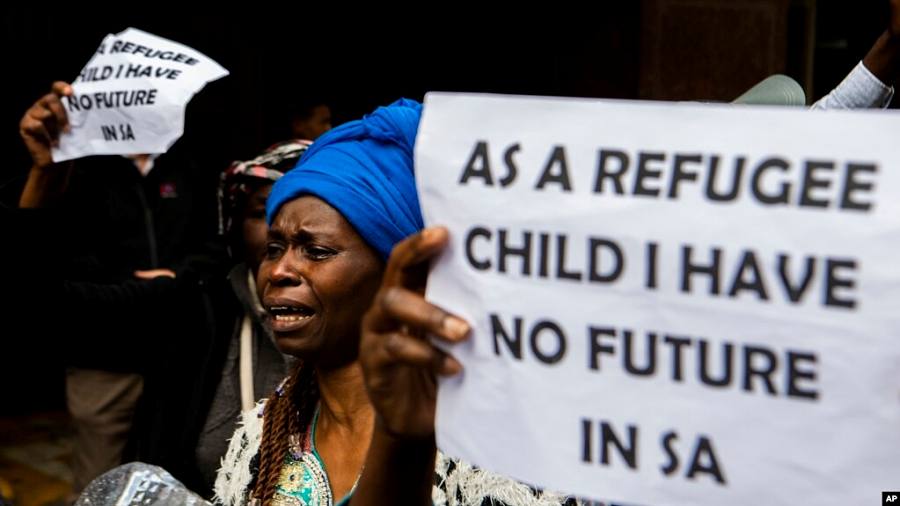![]() FILE – A woman protests with others outside the U.N. refugee agency offices in Cape Town, South Africa, Oct. 30, 2019.
FILE – A woman protests with others outside the U.N. refugee agency offices in Cape Town, South Africa, Oct. 30, 2019.
Fri 25 August 2023:
The media’s huge influence comes from the fact that it’s capable of affecting public perceptions. In the light of this we set out to understand how South Africa’s print media writes about foreigners. And the implications of this representation on local attitudes towards foreign nationals.
Our recently published study looked at the representation of foreigners in some of South Africa’s biggest print and online newspapers. These included the Mail & Guardian, Sowetan, Times Live, Daily Maverick, Independent Online (IOL) and News24.
Foreigners make up about 7% (4 million people) of the country’s population. Their presence in the country receives a great deal of media attention and has sparked a number of xenophobic attacks. Between 1994 and 2021 there were 796 incidents resulting in 588 killings, 1,000 physical assaults and almost 4,700 foreigner-owned shops looted.
This xenophobia also has an attitudinal dimension. A 2013 survey noted that about 44% of South Africans didn’t agree with granting asylum to refugees, 45% said foreigners shouldn’t be allowed to live in the country and 67% didn’t trust foreigners. A more recent study asked respondents to mention the reasons behind anti-immigrant hate crimes: 51% blamed foreigners while only 23% blamed locals.
As researchers in Political Science and Sociology, we were interested in how South Africa’s print media portrays foreign nationals. And how this can influence public attitudes. Many researchers have argued that such representation can determine power relations in society. The media’s potential to influence public opinions on immigration and other social issues, is increased by its capacity to disseminate its representations at scale.
Our findings showed that the media often used language that portrayed foreigners in a bad light, and dehumanised them. We argue in our paper that this has the potential to trigger violence against the perceived invaders.
We also found that the language used was often alarmist when it came to the size of the African immigrant population in South Africa. This created the sense that the country has an overwhelming number of immigrants. This is not true.
We conclude that there’s an urgent need to find a solution. We believe that part of the solution lies in rectifying erroneous public perceptions about foreigners.
How the media portrays foreign nationals
We found a common trend in the way the South African media describes the immigrant population. For instance, without incorporating academic or other credible research, there is loose use of adjectives such as “undocumented” or “illegal” when referring to African foreign nationals.
This reinforces the impression that all foreigners are undocumented and illegal.
Our research also highlighted the use of imprecise but nonetheless suggestive quantification of the African immigrant population. The media frequently used expressions such as “huge numbers”, “many foreigners”, “thousands of immigrants”, “millions of foreign nationals”, “over 300 illegal foreigners”, and “a vast number”.
We also noticed the use of dehumanising metaphors. This is mostly done through likening African immigrants to nonliving objects such as water, cargo or natural disasters that must be controlled. Often the movement of foreigners in the country was described using terms like “massive influx”, “abnormal influx”, “flooding to South Africa’, and “trickling into”, “roaming free”, “descended”, “fled” or “flocked”.
In some instances, the threat level was emphasised through describing the immigrant population as having “taken over” and being an “added burden” to the country. Correspondingly, war terms and phrases such as “crackdown”, “leading the charge”, “operation to rid” and “protect porous borders” were used to signal a response while reinforcing the notion of an impending invasion.
Another issue our study investigated was how the media attached meanings to words. Words such as immigrants and foreigners were often accompanied by verbs such as “blame”, “arrest”, “deport”, “employ”, “suspect”, “hold”, “transfer”, “scapegoat”, “prevent”, “dislike” and “kick”.
Some of the common verbs associated with foreigners were “steal”, “overrun”, “commit”, “dominate”, “enter”, “continue” and “occupy”. The choice of these verbs perpetuates the narratives that foreigners commit crime, and have overrun, dominated, and occupied South Africa.
Us versus them
Corresponding to the negative depiction was the creation of separate identities (us versus them). Mostly, this was done by downplaying the negative traits of South Africans while emphasising their positive traits. The positive traits of African foreign nationals were minimised and their negative traits highlighted.
An example of how the negative actions of South African citizens are downplayed (or even concealed), was in media reports of xenophobic violence. These sought to conceal the agency of locals through the use of verbs as nouns and the selective use of passive and active voices.
The use of verbs to replace words that identify a class or group of people (nouns), leads to headlines like “Xenophobic attacks spread in Gauteng”, “Overnight xenophobic violence rocks Johannesburg”, and “Night of horror for Malawians as attacks on foreigners hit Durban”.
The terms “xenophobic attacks”, “xenophobic violence”, “attacks’, and “looting” were often turned into nouns in a way that hid the perpetrators of the xenophobic violence.
In contrast, we noticed how the agency of foreigners was highlighted in negative reports with headlines such as “More than half of violent crimes in Gauteng committed by illegal immigrants”.
Apart from the polarising nature of language use, one of our most important findings was that of unequal access to the media. Our study found that politicians (often critical of immigration) dominated media debates on foreigners. Reported speech from political elites was often reproduced without any critical analysis, followed by civil society and academics. Foreigners were quoted in only 14% of the reported speeches.
What should be done
The causal relations between media discourse and public attitudes have not been scientifically proven. Nevertheless it’s plausible to argue that the media has the potential to shape public attitudes.
The statements, views and opinions expressed in this column are solely those of the author and do not necessarily represent those of Independent Press.
Authors:
![]()
Sikanyiso Masuku
Research Fellow at The Thabo Mbeki African School of Public and International Affairs (TM-School), University of South Africa
Sikanyiso Masuku graduated with a Doctor of Philosophy in Conflict Transformation and Peace Studies from the University of KwaZulu Natal.
Sikanyiso Masuku has worked as a development and humanitarian practitioner for both regional and international Non-Governmental Organisations. Dr Masuku also teaches both undergraduate and post-graduate classes with a general interest in areas such as social development and welfare, poverty/inequality, social theory and development economics.
A published author in international, peer reviewed journals and monographs, Dr. Masuku has particular research interests in social protection, the politics of belonging/citizenship, human mobility and migration.
This Article Originally Published in The Conversation Click Here
______________________________________________________________
FOLLOW INDEPENDENT PRESS:
TWITTER (CLICK HERE)
https://twitter.com/IpIndependent
FACEBOOK (CLICK HERE)
https://web.facebook.com/ipindependent
Think your friends would be interested? Share this story!





